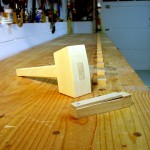Low temperatures make the shop a “no cure zone” for epoxy, thus postponing the next boat building steps.
So, something else is in order … more tools. When I first built the workbench, I made a few simple bench dogs from some sort of not-so-hard Indonesian hardwood found at the Borg. They have served well, but have not lasted well. The remainder of a piece of Ash called out for use. It was left over from getting out structural parts for the Mill Creek 13 boat. I ripped off one strip to 1 inch by 13/16, and another to 3/16 by 13/16. The thicker piece was cut into lengths, making the bodies for 24 bench dogs. The thinner strip was cut into 48 pieces, making the top faces, and the spring pieces.  The springs get their action from being screwed onto a bevel at the bottom of each dog. One is shown resting on the bench in the photo. (As always, click the photo to see larger version.)
The springs get their action from being screwed onto a bevel at the bottom of each dog. One is shown resting on the bench in the photo. (As always, click the photo to see larger version.)
The mallet is one of the “Two Mallets that Followed Me Home” from a while back. Several pieces from that small log seem dry enough to use. I have no moisture meter. My only measure is that the temperature of a freshly cut end is the same as a broad surface. A too wet piece usually feels cooler at the fresh cut. You also get juicy shavings when planing wood that is too wet. This wood made dry shavings. The mallet’s design is the age old design of fitting a tapered handle into a mortise in a rounded head with angled faces. I used no plan, cutting the parts to what could be gotten from two pieces of the log. The head is laminated from two pieces, gently curved across the top, and with faces angled 10 degrees from the handle’s axis. The top surface of the head measures 4 and 3/4 inches by 2 and 1/4 inches. The mallet will get a couple of coats of BLO finish shortly.
There’s more wood from that log, easily enough for the second mallet. Yet, maybe it wants to be a small turning saw instead?
The mallet came out great! Is there a particular reason you wedged the handle instead of relying on the wedge effect of the tapered handle?
Why so many dogs? I guess if you make a couple, you might as well make a few more.
Good questions TJH (and sharp eyes)
The easy answer for the wedged handle is “Can’t be too safe; Use both a belt and suspenders.”
However, the real answer is a bit embarrassing. The mallet’s head is laminated from two pieces, each containing half the mortise. My incredibly careful layout and perfect mortising ended up with an exquisite mortise (heh-heh), but left the pieces a couple of degrees away from perfect mating. I could recover by staying with the tight mortise and sacrificing some of both the top and bottom surfaces of the head, or join the head pieces the way I wanted and “adjust” the mortise. Taking the second option resulted in a sloppier mortise and the wedge made it all tight again. (This is how we learn.)
Jameel recently filled up all the dog holes in his bench, and mentioned how convenient it is no longer having to go find dogs. They’re always exactly where you want them.
I learn all the time!
One more question about the dogs – why is the top piece cross-grain? Is it because it was cut from the spring stock (and, consequently too narrow)?
Exactly TJH.
Using a 3/16″ strip ripped from the edge of the ash stock (13/16″ thick) was “cheaper” than ripping another 1″ strip and then ripping from it the 3/16″ strip needed to match the grain. After all, it’s workshop “bench furniture,” not board room, or even household furniture.
Greg Rössell, an instructor at the Wooden Boat School would remind the cabinetmakers in the class, “We’re building a boat, not a grand piano.”
Then again, if you like fine cabinet making, wander over and see Tom Fidgen’s fine work.